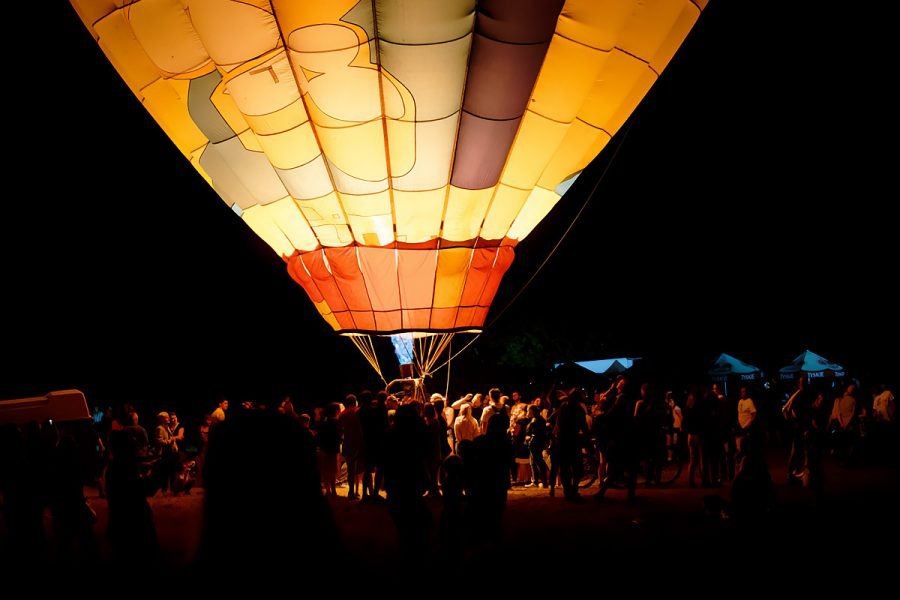Balloon flights are gaining popularity as an unusual form of team integration and enhancement of corporate events. This unique activity provides participants not only with impressive views, but also a shared experience full of emotions.
Hovering above the ground in the basket of a balloon creates favorable conditions for building relationships, breaking down communication barriers and strengthening cooperation. The peace and quiet that prevail during the flight foster open conversations that can lead to better understanding within the team.
The balloon preparation process itself requires coordination and cooperation, which is a valuable exercise in teamwork skills. Companies opting for this form of integration can see long-term benefits, such as improved workplace atmosphere, increased motivation and stronger bonds between employees.
Joint preparation of a balloon as a practical lesson in teamwork
Preparing a balloon for flight provides an excellent opportunity to learn effective cooperation. The process involves all participants and allows practical use of communication and organizational skills.
Division of roles and responsibilities
A key element of effective cooperation is the proper division of tasks. During the preparation for the flight, the team can be divided into groups responsible for different stages of activities.
One group may be in charge of unfolding the balloon shell, another of preparing the basket and burner, and another of coordinating activities and communicating with the pilot. This division facilitates the organization of work and allows each participant to contribute to the goal. It also teaches responsibility for assigned duties and emphasizes the importance of cooperation.
Communication and coordination of activities
Effective communication is the foundation of good cooperation. During flight preparations, it is necessary to exchange information and coordinate activities on an ongoing basis.
It is important to communicate instructions accurately and to be able to listen actively. Team members learn to report progress on tasks and signal possible difficulties. This process helps develop the communication skills necessary for daily teamwork.
Problem solving and adaptation
Preparing a balloon for flight often requires dealing with unforeseen situations, such as changing weather conditions or technical problems. At such moments, the team must demonstrate flexibility and the ability to make quick decisions.
- Situation analysis and problem identification
- Brainstorming to find solutions
- Selection of the best option and its implementation
- Evaluation of the effectiveness of the actions taken
Experiences like these show the importance of being able to adapt to changing circumstances and jointly find solutions.
Tip: Rotating roles during successive flight preparations allows each team member to learn the specifics of different tasks and better understand the work of others.
Building trust and mutual support
Preparing a balloon together requires mutual trust. Each person must rely on the skills and commitment of the other team members, which strengthens the relationship and the sense of responsibility for joint success.
This process also shapes the ability to give and receive support. Learning to recognize the moments when help is needed and being ready to offer it are of great importance in day-to-day group work.
Preparing a hot air balloon together is not only a lesson in the technical aspects of operating the equipment, but more importantly a practical lesson in cooperation. Participants develop key skills such as effective communication, problem solving, adapting to change and building trust. The lessons learned in the process translate into improved team effectiveness and better work dynamics.
How does a joint balloon flight help break down barriers between employees?
The unique atmosphere of a balloon flight promotes the natural blurring of divisions between team members. Soaring above the ground in an enclosed basket space eliminates traditional hierarchical structures, allowing for free interaction.
Neutralizing hierarchy in the airspace
During the flight, all participants become equal partners, regardless of their roles in the company. The lack of fixed seats in the basket and the need to share limited space promotes direct contact between people from different departments and levels of management.
This situation facilitates building relationships based on authenticity instead of professional roles. Employees discover previously unknown qualities of their co-workers, which promotes mutual understanding and a broader perspective.
Creating an environment conducive to openness
The balloon flight takes place in isolation from daily responsibilities, which reduces the tensions associated with work routines. The lack of constant access to electronic devices eliminates distractions, allowing full focus on face-to-face communication.
Factors that support barrier-breaking:
- Shared experience of novelty and uncertainty
- The need to work together to observe the terrain
- Synchronization of responses to changes in flight direction
Tip: Mixed garbage can crews, bringing together employees from different departments, can foster the integration of people who rarely work together on a daily basis.
Strengthen bonds through shared emotions
Intense flight experiences – from the excitement at takeoff to the reflective calm during the flight – activate mechanisms of social emotional arousal. Experiencing strong sensations together fosters deeper relationships beyond standard office interactions.
Research indicates that groups sharing intense emotions are more likely to:
- Share personal stories
- Seek compromise in disputes
- Support each other in stressful situations
The effect lasts long term, improving communication within the organization. The balloon flight becomes a reference point for future conversations, acting as a metaphorical “common language” for the team.
Overcoming fears and strengthening team bonds with balloon flights
A balloon flight is not only an exciting experience, but also an opportunity to overcome fears and strengthen team relationships. Overcoming challenges such as fear of heights together fosters trust and a sense of support within the group.
Overcoming fear as a step towards development
For many people, flying in a balloon can be anxiety-provoking, especially related to altitude. However, the experience allows one to confront one’s limitations in a safe, controlled environment. Experiencing such moments together strengthens solidarity and motivates people to overcome difficulties.
During the flight, participants learn:
- Dealing with emotions in stressful situations
- Trusting other team members and the pilot
- Transcending their own boundaries in a supportive atmosphere
Tip: A short relaxation session before the flight can help to calm down and focus on the positive aspects of the experience.
Creating shared memories as a foundation for bonding
Intense emotions, such as the excitement of the takeoff or the awe of the views from altitude, create unforgettable memories. Such moments become a point of reference for the team, strengthening the sense of unity and belonging.
In-flight bond-building elements:
- Sharing impressions on the fly
- Joint observation of landscapes and exchange of insights
- Mutual support in moments of uncertainty
Teams that share such experiences often notice improved communication and a greater openness to cooperate in daily work tasks.
The symbolic significance of flying together
A balloon flight can serve as a metaphor for the development of a team – from preparation on the ground to reaching new heights. The process shows that cooperation and mutual support play a key role in overcoming challenges and striving for success.
Symbolic benefits:
- Flight as a symbol of crossing boundaries and gaining new perspectives
- Achieving the goal together – floating above the ground as a result of teamwork
- Reflection on the importance of cooperation in everyday professional life
A balloon flight not only inspires action, but also leaves a lasting impression, motivating further development at both the individual and group levels.
Hot air balloons as a unique motivational tool for employees
Balloon flights offer a unique alternative to traditional forms of rewards. Unlike financial bonuses, which are often treated as a standard element of compensation, such an experience remains in the memory for years to come and evokes authentic emotions.
Research published in the Human Resource Management Journal indicates that incentive programs based solely on financial reward can exacerbate work-related pressures, while non-financial forms of recognition yield better results.
The advantage of experiential rewards over material rewards
Tangible rewards, such as tablets or smartphones, do not always have the desired motivational effect. An employee may already own a similar device or may not feel the need to own one.
A balloon flight, on the other hand, is an experience that many people perceive as a unique experience. Such a reward is perceived as a genuine distinction rather than a standard salary supplement.
Benefits of choosing balloon flight as a reward:
- No burden of taxes and contributions that reduce the value of financial bonuses
- Creation of a personal and unique distinction
- Immediate gratification without months of waiting
Balloon flights are also relatively affordable compared to other exclusive rewards, making them accessible to smaller companies as well. The cost of such an experience is usually between 500 and 700 zloty per person, which is a reasonable investment in team motivation.
Building an organizational culture based on appreciation
Rewarding employees with balloon flights contributes to the company’s positive image as an organization that values creativity and an out-of-the-box approach.
Photos of the flight, certificates of participation and a champagne toast after landing become visible symbols of success that can be displayed in the office space. Employees often share their impressions with colleagues, which builds interest in a similar award among other team members.
Photographs of smiling flight participants, posted on a company bulletin board, provide tangible proof of recognition and inspire other employees to perform better.
Tip: Instead of awarding a balloon flight as an individual prize, you can introduce a program in which employees nominate colleagues for exceptional performance. This arrangement increases team engagement and reinforces a culture of mutual appreciation.
Measurable motivational effects
The effectiveness of balloon flights as a motivational tool can be assessed in two ways. First, by analyzing employee feedback on this type of recognition. Second, by observing changes in key business indicators after implementing such a program.
Studies show that employees who feel appreciated:
- Are less likely to take sick leave
- Are more likely to meet or exceed their goals
- Show greater loyalty to their employer
- Are more actively involved in the life of the organization
Balloon flight as a business metaphor also carries symbolic meaning. The unpredictability of the direction of flight, dependence on weather conditions and the need to adapt to changing circumstances perfectly reflect the realities of the modern world of work.
Such experience teaches flexibility and the ability to adapt to new situations – qualities highly valued in a dynamic professional environment.
Fostering leadership and cooperation by organizing balloon flights for companies
Balloon flights are an unusual form of developing leadership skills and strengthening cooperation in teams. Unlike traditional training sessions held in conference rooms, such an experience creates a natural environment where the roles of leaders and team members can be observed and refined under authentic conditions.
Developing leadership skills in an unusual environment
When organizing a balloon flight, leaders naturally emerge to coordinate the group’s activities. Observing the behavior of participants in this unusual situation makes it possible to identify individuals with leadership aptitudes that may not show up in an everyday office environment.
Managers can test different management styles, adapting them to the dynamically changing conditions of flight. Organizers offer programs in which participants rotate responsibility for various aspects of the expedition. This formula allows everyone to experience a leadership role in a safe environment, under the guidance of an experienced pilot.
It is particularly valuable to observe how leaders react to unforeseen situations, such as sudden changes in wind direction or the need to make a quick landing decision. These moments provide an excellent analogy to business challenges, where flexibility and adaptability are key.
Building trust between management and employees
A joint balloon flight creates an opportunity to blur hierarchical boundaries. In the basket of the balloon, all participants are on the same level, which encourages more open communication and the building of authentic relationships.
Elements to increase trust:
- Sharing risk and responsibility for the safety of the group
- Mutual reliance on each other in situations that require cooperation
- Openness to sharing the fears and joys of the flight
Tip: Before the flight, it’s a good idea to schedule a short session where participants can express their expectations and concerns. After the expedition, a debriefing meeting will allow you to analyze the lessons learned and discuss their application in your daily work.
Practical application of flight experience in a business environment
Companies such as ProBallooning, which specialize in organizing group flights for businesses, offer customized programs for organizations. This allows you to design an experience that addresses specific business challenges.
After the flight, it is useful to have a moderated discussion to help participants identify key moments of collaboration and leadership.
Sample questions for analysis:
- What leadership behaviors were most effective in preparing for the flight?
- How did the team deal with uncertainty about the direction of the flight?
- Which elements of communication supported effective collaboration?
- How to apply these observations to everyday business challenges?
Balloon flights for companies are organized throughout the year, allowing the event to flexibly fit into the organization’s development schedule. The availability of different locations, offered by companies such as Ballooning.co.uk, allows you to tailor the experience to your group’s preferences and needs.
Balloon flight safety a foundation for building trust within a group
Safety during hot air balloon flights is a priority, which at the same time fosters trust within the team. Studies show that companies organizing balloon flights for corporate groups place special emphasis on safety procedures. This makes participants feel more secure and allows them to focus on the integrative aspect of the experience.
Professional safety procedures as part of integration
Each flight begins with a briefing by an experienced pilot. During such a briefing, participants learn the rules of behavior in the basket, landing position and other important guidelines. This is the first moment of building trust – participants rely on the pilot’s knowledge and follow his instructions.
Professional organizers conduct a thorough inspection of the shell, rigging and nacelle before each flight. Knowing that the equipment is regularly inspected by certified aeronautical institutions gives a sense of security and allows you to focus on the experience itself.
Balloon operators do not take off in adverse weather conditions, such as high winds or unstable weather. Such attention to safety teaches teams that sometimes it’s better to abandon a plan rather than put the group at risk – a valuable lesson that can be transferred to business.
Mutual responsibility and support during the flight
Participants in a balloon flight are in a situation of mutual dependence – each person’s safety depends on the behavior of the other members of the group. This shared responsibility naturally leads to building trust and a sense of unity.
Tip: Before the flight, you can organize a short exercise where participants in pairs share their concerns and partners suggest ways to support each other. Such an activity fosters a sense of emotional safety within the group.
Psychological research shows that experiencing trusting situations together strengthens interpersonal relationships. In the basket of a balloon, where space is limited and participants must respect safety protocols, an environment of cooperation and responsibility for others is naturally created.
More than 60% of passengers experience a fear of heights before flying. However, once up in the air, thanks to the calm atmosphere and support of the group, these fears usually subside. Overcoming fears in a safe environment is a powerful tool for building trust within a team.
The role of certified pilots in creating an atmosphere of trust
Experienced pilots play a key role in creating a sense of security in a group. Their professionalism, knowledge and communication skills ensure that participants can fully enjoy the flight experience.
Certified pilots have licenses issued by the relevant civil aviation authorities and hours of experience in the air. Their competence allows them not only to guide the balloon safely, but also to educate participants about aeronautics and the specifics of flight.
During the flight, the pilot becomes a natural leader of the group, demonstrating the qualities of an effective leader: poise, the ability to make decisions in dynamic conditions and clearly communicate expectations. Observing these skills provides a valuable lesson for participants, especially for those in leadership positions.
Safety equipment components:
- Redundant fuel systems and burners
- Fire extinguishers suitable for extinguishing propane fires
- Alternative ignition sources
- Ropes for maneuvering the balloon during landing
- Communication systems with the ground crew
Balloon flights are considered one of the safest forms of aviation. Accident statistics are extremely low, confirming the effectiveness of the procedures used. Awareness of this fact allows participants to focus on the integration aspect of the event, which fosters an atmosphere of trust and cooperation.
The impact of shared flight experiences on long-term relationships between employees
Shared balloon flight experiences create lasting memories that have a significant impact on employee relationships. Studies show that sharing unique experiences builds stronger bonds than standard integration activities, and the effects of such an experience persist in the work environment for months.
Creating a common language and reference points
The extraordinary experience of a balloon flight becomes part of the company’s history and shapes a unique language of communication. Employees often refer to moments from the flight during daily interactions, using metaphors and references understood only by the participants of the event.
Shared experiences provide a reference point for team communication. Phrases such as “do you remember the view from above?” or “like when we were hovering above the forest” enter the daily vocabulary, reinforcing a sense of belonging and shared history.
Psychological research indicates that shared emotional memories form what is known as collective memory, which is the foundation of group identity. Employees who have shared an intense experience, such as a balloon flight, feel a stronger identification with the team and the organization.
Breaking down formal and hierarchical barriers
Balloon flight creates a space where formal organizational structures lose their importance. Managers and lower-level employees experience the same adventure, leading to authentic relationships and greater openness in the workplace.
A study by Seattle Ballooning found that after a joint flight, employees are more likely to interact with people from other departments and levels of the organization. Reducing formal barriers facilitates collaboration and communication, resulting in more effective teamwork.
Tip: After the flight, it’s a good idea to hold an informal meeting where participants can exchange photos and impressions. Such an event reinforces the positive effects of the experience and prolongs its impact on team relations.
Long-term effects of a shared experience
The shared experience of an airborne adventure has a lasting effect on team atmosphere and organizational culture. Team building experts indicate that the emotional effects of a balloon flight last much longer than traditional forms of integration.
Long-term benefits for the team include:
- Greater trust between employees
- Better informal communication
- Greater willingness to cooperate and help each other
- Reduction of interpersonal conflicts
- Stronger identification with the company and its values
Companies that organize balloon flights for teams emphasize that the shared experience in the air affects team dynamics more profoundly than traditional training. Employees who have overcome their fears together and shared the emotions of the flight show greater empathy and understanding for each other in everyday work situations.
Psychological research confirms that experiencing intense emotions together, such as excitement or awe at the view, releases oxytocin, the hormone responsible for building social bonds. This biochemical effect translates into a lasting strengthening of interpersonal relationships within the team.
Elements of the shared experience that most strongly influence relationships:
- Overcoming fears and challenges together
- Sharing moments of delight and discovery
- A sense of exclusivity and uniqueness of the experience
- Separation from daily life and work routine
- Creating memories beyond the context of work
A balloon flight is not just a momentary attraction, but an investment in lasting relationships between employees. Hovering above the ground creates strong bonds that translate into a better work atmosphere, more effective communication and greater identification with the team. These effects last long after landing, providing valuable social capital for the organization.
Summary
Hot air balloon flights are a unique tool for integration and motivation of corporate teams. Preparing the balloon together develops cooperation and communication skills, and the flight itself fosters the breaking down of barriers between employees at different levels of the organization. Such an experience helps overcome personal fears in a supportive atmosphere, which strengthens group bonds.
Unlike traditional financial rewards, a balloon flight remains in the memory for years to come, creating lasting memories and reference points for the team. The crucial aspect of safety builds a foundation of trust, which translates into daily working relationships.
More and more organizations are recognizing the importance of such experiences in developing leadership competencies and fostering collaboration. The shared flight experience shapes a unique team language and eliminates formal barriers, which improves communication and workplace atmosphere.
Investing in a balloon flight is not just an attractive enhancement to a corporate event, but also a strategic measure to support the building of a strong, integrated team capable of effective cooperation in a dynamic business environment.





